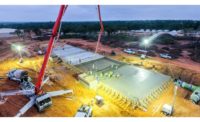Clark Construction seems to have taken to heart the slogan “Everything is bigger in Texas.” Throughout its 30 years in the Texas market, the national firm, which is headquartered in Bethesda, Md., has focused on large jobs. But in recent years that strategy reached a new level as Clark—in a joint venture with Hunt Construction—added such megaprojects as the $730-million San Antonio Military Medical Center. The firm's Texas portfolio has amassed a combined value of $2.6 billion over three decades, with its current projects comprising $1.1 billion of that tally.


And more megaprojects are on the horizon. The firm expanded its reach into Louisiana last year when it was selected to build the $995-million Southeast Louisiana Veterans Healthcare System Replacement Hospital in New Orleans as part of a joint venture with McCarthy Building.
Given the firm's ability to successfully position itself for regional growth during a down economy, ENR Texas & Louisiana named Clark Construction its 2011 Contractor of the Year.
Through a combination of major health-care and airport projects, Clark Construction far outpaced its competition last year. In 2009, the firm garnered $283 million regionally. The following year, that tally more than doubled to $654 million, rocketing Clark from number 30 to number six in our ranking of Top Contractors in Texas and Louisiana.
Thinking Big
In forging a regional growth strategy, Sid Jordan, CEO for the firm's northern-southern region, thinks big. Large, complex projects on which Clark can leverage its expertise and prove its value are primary targets, he says.
While the company strives to maintain a consistent presence in the region, it stays disciplined in its approach. Jordan says Clark is careful to not overcommit itself with unnecessary overhead expenses, focusing instead on establishing more direct contact with clients.
“We've been in continuous operation in Texas for 30 years, and we have employees who have lived in the state all that time and never left,” he says. “We've had local offices here in the past and now we don't, but we have a bigger presence [in the state] than ever. The strategy is to take the money we would have spent on those administrative costs and instead focus on having officers of the company [in state] who can be deployed to most, if not all, jobs. The result is we work more efficiently in terms of the decision-making processes, timeliness and competitiveness. We can be more nimble.”
Making History
Although its regional revenue spiked last year, Clark's success isn't sudden. Over the years, it has added dozen of large projects to its Texas portfolio. In Houston, major projects include the $127-million M.D. Anderson Cancer Center, completed in 1998, and the 1500 Louisiana office tower, which it finished in 2002. The firm has worked continuously on projects for the Houston Airport System for more than a decade. In July, Clark completed a five-year $250-million renovation project at Houston's William P. Hobby Airport.
In San Antonio, Clark built the $232-million Brooke Army Medical Center at Fort Sam Houston in 1995, and expanded the San Antonio Convention Center in 2001. Now it is back at Fort Sam Houston, working on the military hospital project, which includes a renovation of the Brooke army facility it originally built. Meanwhile, it constructed the $158-million Terminal B at San Antonio International Airport, which opened in November, as part of a joint venture with Thos. S. Byrne.
Jordan says Clark's approach is to maintain a strong presence, but remain strategic. “We look at it like a nautilus shell, where the job becomes the center of the universe and prospects extend from there,” he says.
As part of that approach, Jordan engages operations staff in business development opportunities. “As a national player, we can move people around from job to job, but we have people who like an area and want to stay there,” he says. “We tell them, 'Be successful on this job and create opportunities for other work that will keep you here.' It's a decentralized approach, but it works.”





Post a comment to this article
Report Abusive Comment